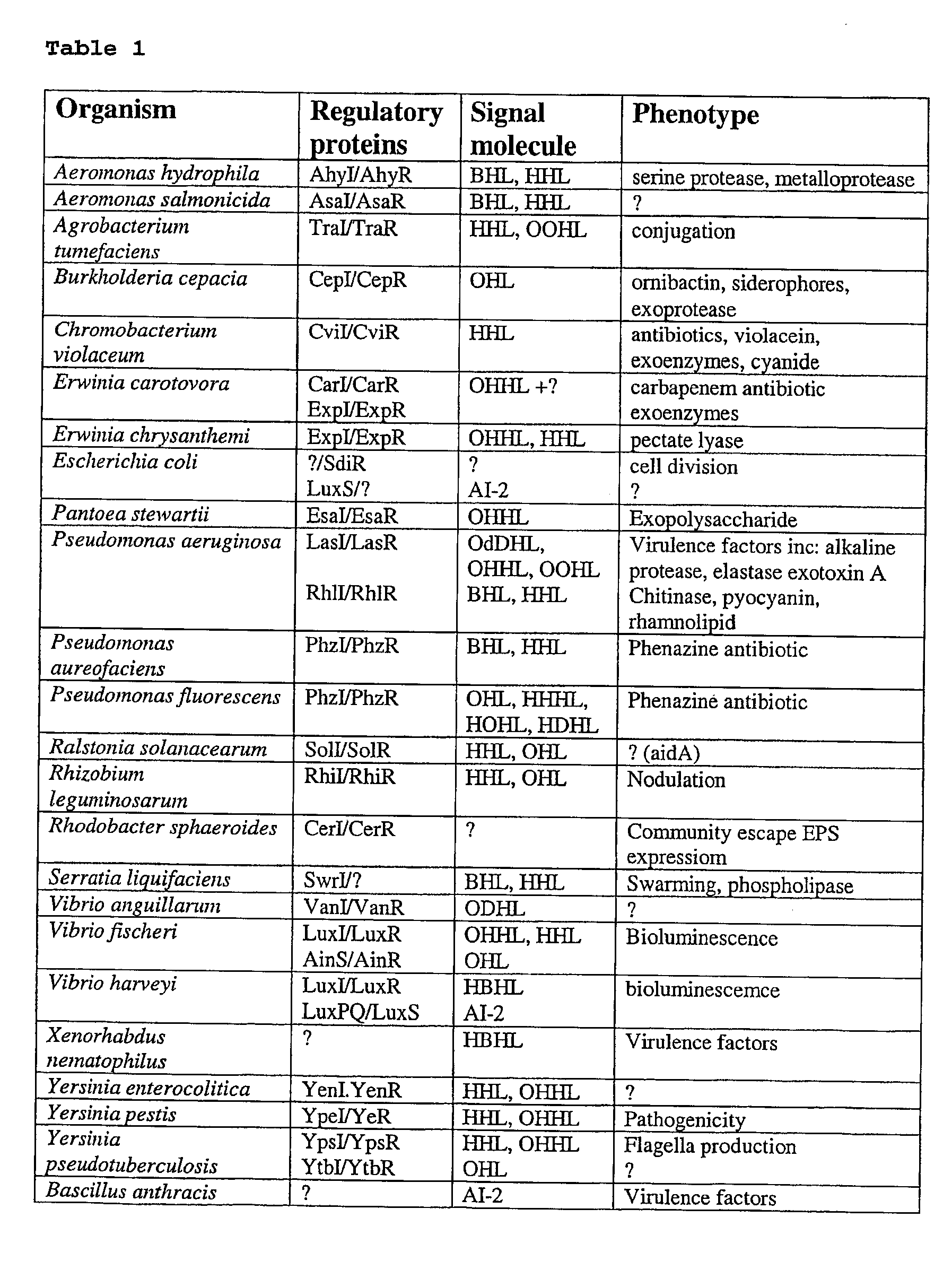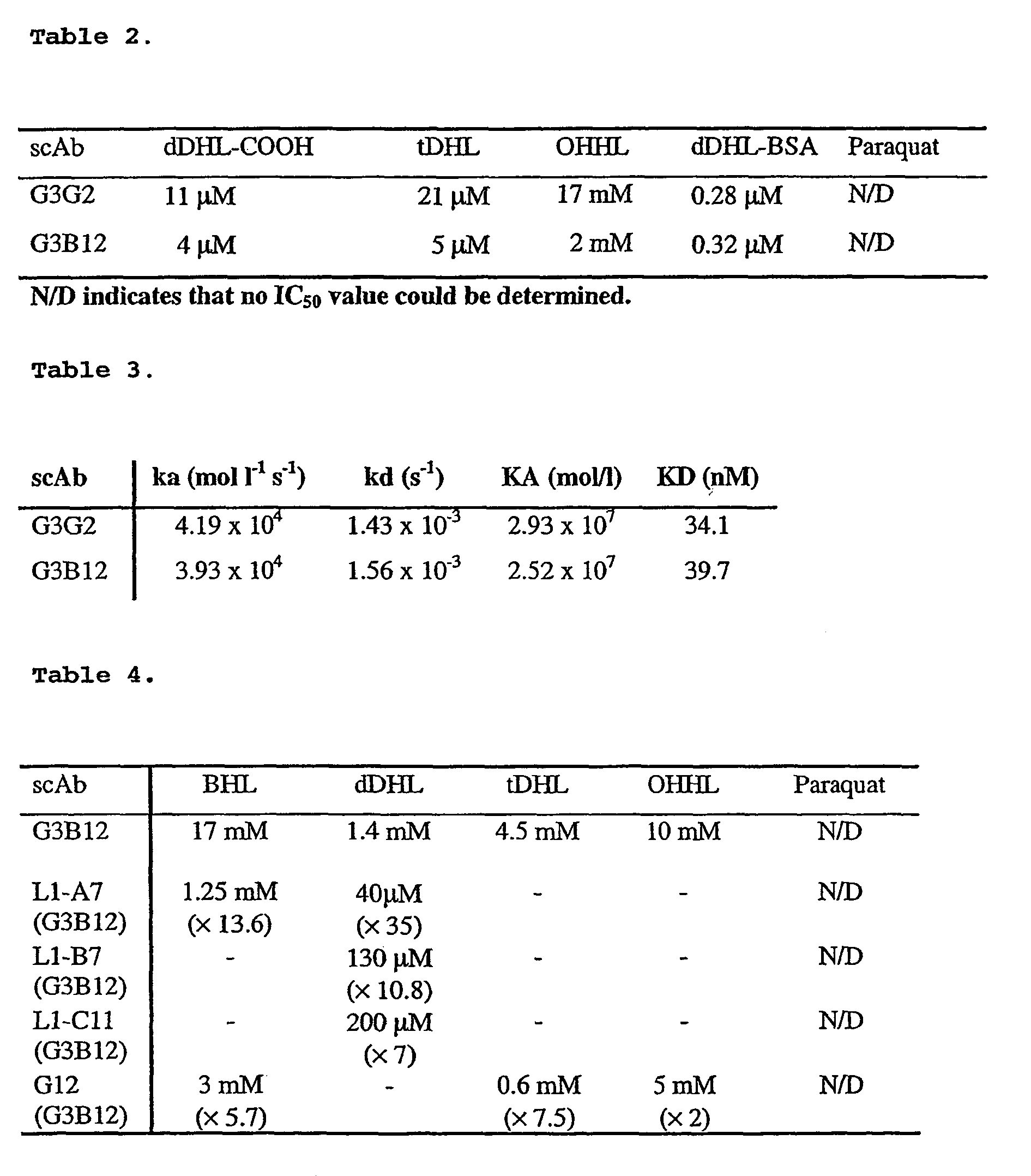Methods for the treatment of an infectious bacterial disease with an anti-lactone or lactone derived signal molecules antibody
a technology of signal molecules and infectious bacteria, which is applied in the direction of biocide, cyclic peptide ingredients, active ingredients of heterocyclic compounds, etc., can solve the problems of high patient morbidity, difficult, if not impossible, to treat, and the colonisation of cystic fibrosis patients by mucoid strains of ps. aeruginosa /i> is common and difficult to treat, so as to improve patient compliance and reduce the risk of resistan
- Summary
- Abstract
- Description
- Claims
- Application Information
AI Technical Summary
Benefits of technology
Problems solved by technology
Method used
Image
Examples
example 2
[0125]To assess the ability of anti-HSL scabs to afford protection to animals against pathogenic Ps. aeruginosa, a ‘slow-killing’ assay using the nematode C. elegans was employed. This assay is based on the killing of the worms following establishment of a Ps. aeruginosa infection in the animal's gut.
[0126]Ps. aeruginosa strain PA14 was infected into 5 ml LB broth on day 1 and incubated overnight at 37° C. On day 2, 1% of the overnight culture was inoculated into 5 ml fresh LB with 100 μl scAb at 100 nM broth and incubated at 37° C. to OD 600 nm of 0.4. Ten microliters bacterial culture was spotted onto the centre of NG enriched peptone agar plates (nematode growth media), together with 50 μl scAb at 120 nM and plates incubated overnight at 37° C. On day 3 (μm) an additional 50 μl scAb (120 nM) was spotted onto the plates and incubation continued overnight. On day 4 (am) the plates were transferred to room temperature (−20° C.) and a further 50 μl scAb added. On day 5 (am), 50 μl sc...
example 3
[0130]Ps. aeruginosa produces several extracellular products that, after colonisation, can cause extensive tissue damage. One of these, elastase, is essential for maximum virulence of Ps. aeruginosa during acute infection. The production of elastase is under the control of the lasI / R quorum-sensing cascade. The detection of elastase production can therefore be used as an indicator of the capacity for virulence of the bacterial population.
[0131]Four microliters Ps. aeruginosa strain PA14 at 10 sup 5 CFU per ml (low OD) or 10 sup 8 CFU per ml (high OD) were inoculated onto agar plates containing 1% elastin, 0.5% lab lemco powder, 1% peptone, 0.5% sodium chloride and 1.5% agar, and incubated at 37° C. for 5 days. Growth to low OD discourages pathogenic switching, whereas growth to high OD encourages pathogenic switching. Fifty microliters of scAb (200 nM) was added to the plates together with the bacteria, and additional applications of the same volume made at 24 h intervals throughout...
example 4
[0133]In order to isolate anti-HSL antibodies with higher affinity for antigen, and to direct specificity towards particular HSL variants, affinity maturation was performed on clone G3B12. Phagemid DNA was isolated from the G3B12 bacterial clone, and the variable light chain gene amplified by PCR using a 5′ oligonucleotide primer, LINER-REV comprising the last 30 bases of the 45 base-pair flexible linker region (5′-GGCGGAGGTGGCTCTGGCGGTAGTGC-3′) and a 3′ primer gil-FOR (5′-GAATTTTCTGTATGAGG-3′), specific for the phage minor coat protein gene gIII Product of the correct size (˜380 bp) was electrophoresed in a 1% agarose gel, excised, and purified. In a similar way, phagemid DNA containing the entire human naïve library from which the original clone was isolated was prepared. The whole repertoire of variable heavy chain genes was amplified using the 5′ primer AH1-REV (5′-AAATACCTATrGCCTACGGC-3′) specific for the pelB leader sequence, and the 3′ primer LINKER-FOR encoding the first 30 ...
PUM
| Property | Measurement | Unit |
|---|---|---|
| particle size | aaaaa | aaaaa |
| pH | aaaaa | aaaaa |
| concentrations | aaaaa | aaaaa |
Abstract
Description
Claims
Application Information
 Login to View More
Login to View More - R&D
- Intellectual Property
- Life Sciences
- Materials
- Tech Scout
- Unparalleled Data Quality
- Higher Quality Content
- 60% Fewer Hallucinations
Browse by: Latest US Patents, China's latest patents, Technical Efficacy Thesaurus, Application Domain, Technology Topic, Popular Technical Reports.
© 2025 PatSnap. All rights reserved.Legal|Privacy policy|Modern Slavery Act Transparency Statement|Sitemap|About US| Contact US: help@patsnap.com



